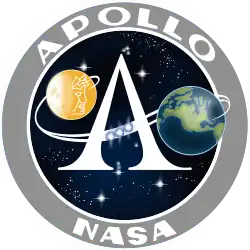
The Apollo program was a United States human spaceflight program carried out from 1961 to 1972 by the National Aeronautics and Space Administration (NASA), which landed the first astronauts on the Moon.[1] The program used the Saturn IB and Saturn V launch vehicles to lift the Command/Service Module (CSM) and Lunar Module (LM) spacecraft into space, and the Little Joe II rocket to test a launch escape system which was expected to carry the astronauts to safety in the event of a Saturn failure.[2] Uncrewed test flights beginning in 1966 demonstrated the safety of the launch vehicles and spacecraft to carry astronauts, and four crewed flights beginning in October 1968 demonstrated the ability of the spacecraft to carry out a lunar landing mission.
Apollo achieved the first crewed lunar landing on the Apollo 11 mission, when Neil Armstrong and Buzz Aldrin landed their LM Eagle in the Sea of Tranquility and walked on the lunar surface, while Michael Collins remained in lunar orbit in the CSM Columbia, and all three landed safely on Earth on July 24, 1969.[3] Five subsequent missions landed astronauts on various lunar sites, ending in December 1972 with twelve men having walked on the Moon[4] and 842 pounds (382 kg) of lunar rocks and soil samples returned to Earth, greatly contributing to the understanding of the Moon's composition and geological history.[5]
Two Apollo missions were failures: a 1967 cabin fire killed the entire Apollo 1 crew during a ground test in preparation for what was to be the first crewed flight;[6] and the third landing attempt on Apollo 13 was aborted by an oxygen tank explosion en route to the Moon, which disabled the CSM Odyssey's electrical power and life support systems, and made the propulsion system unsafe to use. The crew circled the Moon and were returned safely to Earth using the LM Aquarius as a "lifeboat" for these functions.[7]
Uncrewed test flights
From 1961 through 1967, Saturn launch vehicles and Apollo spacecraft components were tested in uncrewed flights.
Saturn I
The Saturn I launch vehicle was originally planned to carry crewed Command Module flights into low Earth orbit, but its 20,000-pound (9,100 kg) payload capacity limit could not lift even a partially fueled Service Module, which would have required building a lightweight retrorocket module for deorbit. These plans were eventually scrapped, in favor of using the uprated Saturn IB to launch the Command Module with a half-fueled Service Module for crewed Earth orbit tests. This limited Saturn I flights to Saturn launch vehicle development, CSM boilerplate testing, and three micrometeoroid satellite launches in support of Apollo.
| Mission | LV Serial No | Launch | Remarks | Refs |
|---|---|---|---|---|
| SA-1 | Saturn I
SA-1 |
October 27, 1961
15:06 GMT Launch Complex 34 |
Test of Saturn I first stage S-I; dummy upper stages carried water | [1][8][9] |
| SA-2 | Saturn I
SA-2 |
April 25, 1962
14:00 GMT Launch Complex 34 |
Dummy upper stages released 22,900 U.S. gallons (86,685 L) of water into upper atmosphere, to investigate effects on radio transmission and changes in local weather conditions | [1][8][9] |
| SA-3 | Saturn I
SA-3 |
November 16, 1962
17:45 GMT Launch Complex 34 |
Repeat of SA-2 mission | [1][8][9] |
| SA-4 | Saturn I
SA-4 |
March 28, 1963
20:11 GMT Launch Complex 34 |
Test premature shutdown of a single S-I engine | [1][8][9] |
| SA-5 | Saturn I
SA-5 |
January 29, 1964
16:25 GMT Launch Complex 37B |
First flight of live second stage. First orbital flight. | [1][8][9] |
| AS-101 | Saturn I
SA-6 |
May 28, 1964
17:07 GMT Launch Complex 37B |
Tested first boilerplate Apollo command and service module (CSM) for structural integrity | [1][9] |
| AS-102 | Saturn I
SA-7 |
September 18, 1964
17:22 GMT Launch Complex 37B |
Carried first programmable-in-flight computer on the Saturn I vehicle; last launch vehicle development flight | [1][9] |
| AS-103 | Saturn I
SA-9 |
February 16, 1965
14:37 GMT Launch Complex 37B |
Carried first Pegasus micrometeorite satellite (Pegasus A) in addition to boilerplate CSM | [1][9] |
| AS-104 | Saturn I
SA-8 |
May 25, 1965
07:35 GMT Launch Complex 37B |
Carried Pegasus B and boilerplate CSM | [1][9] |
| AS-105 | Saturn I
SA-10 |
July 30, 1965
13:00 GMT Launch Complex 37B |
Carried Pegasus C and boilerplate CSM | [1][9] |
There was some incongruity in the numbering and naming of the first three uncrewed Apollo-Saturn (AS), or Apollo flights. This is due to AS-204 being renamed to Apollo 1 posthumously. This crewed flight was to have followed the first three uncrewed flights. After the fire which killed the AS-204 crew on the pad during a test and training exercise, uncrewed Apollo flights resumed to test the Saturn V launch vehicle and the Lunar Module; these were designated Apollo 4, 5 and 6. The first crewed Apollo mission was thus Apollo 7. Simple "Apollo" numbers were never assigned to the first three uncrewed flights, although renaming AS-201, AS-202, and AS-203 as Apollo 1-A, Apollo 2 and Apollo 3, had been briefly considered.[6]
Saturn IB
The Saturn I was converted to the Uprated Saturn I, eventually designated Saturn IB, by replacing the S-IV second stage with the S-IVB, which would also be used as the third stage of the Saturn V with the addition of on-orbit restart capability. This increased the payload capacity to 46,000 pounds (21,000 kg), enough to orbit a Command Module with a half-fueled Service Module, and more than enough to orbit a fully fueled Lunar Module.
Two suborbital tests of the Apollo Block I Command and Service Module, one S-IVB development test, and one Lunar Module test were conducted. Success of the LM test led to cancellation of a planned second uncrewed flight.
| Mission | LV Serial No | Launch | Remarks | Refs |
|---|---|---|---|---|
| AS-201 | Saturn IB
SA-201 |
February 26, 1966
16:12 GMT Launch Complex 34 |
First test of Saturn IB and Block I Apollo CSM. Suborbital flight landed the CM in the Atlantic Ocean, demonstrating the heat shield. Propellant pressure loss caused premature SM engine shutdown. | [1][6][8][9] |
| AS-203 | Saturn IB
SA-203 |
July 5, 1966
14:53 GMT Launch Complex 37B |
No Apollo spacecraft; instrumentation and video observed on-orbit behavior of S-IVB liquid hydrogen fuel in support of restart capability design for Saturn V. Deemed a success, despite inadvertent destruction of S-IVB during final overpressure tank rupture test. | [1][6][8][9] |
| AS-202 | Saturn IB
SA-202 |
August 25, 1966
17:15 GMT Launch Complex 34 |
Suborbital flight to Pacific Ocean splashdown. CM heat shield tested to higher speed; successful SM firings. | [1][6][8][9] |
| Apollo 5 | Saturn IB
SA-204 |
January 22, 1968
22:48 GMT Launch Complex 37B |
First flight of LM successfully fired descent engine and ascent engines; demonstrated "fire-in-the-hole" landing abort test. | [1][8][9] |
Launch escape system tests
From August 1963 to January 1966, a number of tests were conducted at the White Sands Missile Range for development of the launch escape system (LES). These included simulated "pad aborts", which might occur while the Apollo-Saturn space vehicle was still on the launch pad, and flights on the Little Joe II rocket to simulate Mode I aborts which might occur while the vehicle was in the air.[1]

| Mission | Launch vehicle | Launch | Remarks | Refs |
|---|---|---|---|---|
| QTV | Little Joe II | August 28, 1963
13:05 GMT Launch Complex 36 |
Little Joe II qualification test | [1][9] |
| Pad Abort Test 1 | None | November 7, 1963
16:00 GMT Launch Complex 36 |
Launch escape system (LES) abort test from launch pad | [1][9] |
| A-001 | Little Joe II | May 13, 1964
13:00 GMT Launch Complex 36 |
LES transonic test, success except for parachute failure | [1][9] |
| A-002 | Little Joe II | December 8, 1964
15:00 GMT Launch Complex 36 |
LES maximum altitude, Max-Q abort test | [1][9] |
| A-003 | Little Joe II | May 19, 1965
13:01 GMT Launch Complex 36 |
LES canard maximum altitude abort test | [1][9] |
| Pad Abort Test 2 | None | June 29, 1965
13:00 GMT Launch Complex 36 |
LES pad abort test of near Block-I CM | [1][9] |
| A-004 | Little Joe II | January 20, 1966
15:17 GMT Launch Complex 36 |
LES test of maximum weight, tumbling Block-I CM | [1][9] |
Saturn V
Prior to George Mueller's tenure as NASA's Associate Administrator for Manned Space Flight starting in 1963, it was assumed that 20 Saturn Vs, with at least 10 unpiloted test flights, would be required to achieve a crewed Moon landing, using the conservative one-stage-at-a-time testing philosophy used for the Saturn I. But Mueller introduced the "all-up" testing philosophy of using three live stages plus the Apollo spacecraft on every test flight. This achieved development of the Saturn V with far fewer uncrewed tests, and facilitated achieving the Moon landing by the 1969 goal. The size of the Saturn V production lot was reduced from 20 to 15 units.[10]
Three uncrewed test flights were planned to human-rate the super heavy-lift Saturn V which would take crewed Apollo flights to the Moon. Success of the first flight and qualified success of the second led to the decision to cancel the third uncrewed test.
| Mission | LV Serial No | Launch | Remarks | Refs |
|---|---|---|---|---|
| Apollo 4 | Saturn V
SA-501 |
November 9, 1967
12:00 GMT Launch Complex 39A |
First flight of Saturn V rocket; successfully demonstrated S-IVB third stage restart and tested CM heat shield at lunar re-entry speeds. | [1][8][9] |
| Apollo 6 | Saturn V
SA-502 |
April 4, 1968
16:12 GMT Launch Complex 39A |
Second flight of Saturn V; severe "pogo" vibrations caused two second-stage engines to shut down prematurely, and third stage restart to fail. SM engine used to achieve high-speed re-entry, though less than Apollo 4. NASA identified vibration fixes and declared Saturn V man-rated. | [1][8][9] |
Alphabetical mission types
The Apollo program required sequential testing of several major mission elements in the runup to a crewed lunar landing. An alphabetical list of major mission types was proposed by Owen Maynard in September 1967.[11][12] Two "A-type" missions performed uncrewed tests of the CSM and the Saturn V, and one B-type mission performed an uncrewed test of the LM. The C-type mission, the first crewed flight of the CSM in Earth orbit, was performed by Apollo 7.
The list was revised upon George Low's proposal to commit a mission to lunar orbit ahead of schedule, an idea influenced by the status of the CSM as a proven craft and production delays of the LM.[13] Apollo 8 was reclassified from its original assignment as a D-type mission, a test of the complete CSM/LM spacecraft in Earth orbit, to a "C-prime" mission which would fly humans to the Moon. Once complete, it obviated the need for the E-type objective of a medium Earth orbital test. The D-type mission was instead performed by Apollo 9; the F-type mission, Apollo 10, flew the CSM/LM spacecraft to the Moon for final testing, without landing. The G-type mission, Apollo 11, performed the first lunar landing, the central goal of the program.
The initial A–G[11][14] list was expanded to include later mission types:[1]: 466 H-type missions—Apollo 12, 13 (planned) and 14—would perform precision landings, and J-type missions—Apollo 15, 16 and 17—would perform thorough scientific investigation. The I-type objective, which called for extended lunar orbital surveillance of the Moon,[15] was incorporated into the J-type missions.[1]: 466
| Mission type | Missions | Description |
|---|---|---|
| A | "Unmanned flights of launch vehicles and the CSM, to demonstrate the adequacy of their design and to certify safety for men."[14][lower-alpha 1] | |
| B | Apollo 5 | "Unmanned flight of the LM, to demonstrate the adequacy of its design and to certify its safety for men."[14] |
| C | Apollo 7 | "Manned flight to demonstrate performance and operability of the CSM."[14] |
| C′ | Apollo 8 | "Command and service module manned flight demonstration in lunar orbit."[1]: 466 |
| D | Apollo 9 | "Manned flight of the complete lunar landing mission vehicle in low Earth orbit to demonstrate operability of all the equipment and (insofar as could be done in Earth orbit) to perform the maneuvers involved in the ultimate mission."[14] |
| E | — | "Manned flight of the complete lunar landing mission vehicle in Earth orbit to great distances from Earth."[14] |
| F | Apollo 10 | "A complete mission except for the final descent to and landing on the lunar surface."[14] |
| G | Apollo 11 | "The initial lunar landing mission."[14] |
| H | "Precision manned lunar landing demonstration and systematic lunar exploration."[1]: 466 | |
| I | — | "Reserved for lunar survey missions." (Not used)[15] |
| J | "Extensive scientific investigation of Moon on lunar surface and from lunar orbit."[1]: 466 |
Crewed missions
The Block I CSM spacecraft did not have capability to fly with the LM, and the three crew positions were designated Command Pilot, Senior Pilot, and Pilot, based on U.S. Air Force pilot ratings. The Block II spacecraft was designed to fly with the Lunar Module, so the corresponding crew positions were designated Commander, Command Module Pilot, and Lunar Module Pilot regardless of whether a Lunar Module was present or not on any mission.[16]
Seven of the missions involved extravehicular activity (EVA), spacewalks or moonwalks outside of the spacecraft. These were of three types: testing the lunar EVA suit in Earth orbit (Apollo 9), exploring the lunar surface, and retrieving film canisters from the Scientific Instrument Module stored in the Service Module.[17]
| Mission | Patch | Launch date | Crew | Launch vehicle[lower-alpha 2] | CM name | LM name | Duration | Remarks | Refs |
|---|---|---|---|---|---|---|---|---|---|
| Apollo 1 |  |
February 21, 1967
Launch Complex 34 (planned) |
Gus Grissom Ed White Roger B. Chaffee |
Saturn IB (SA-204) |
— | — | — | Never launched. On January 27, 1967, a fire in the command module during a launch pad test killed the crew and destroyed the module. This flight was originally designated AS-204, and was renamed to Apollo 1 at the request of the crew's families. | [1][8][18][19][20] |
| Apollo 7 | October 11, 1968
15:02 GMT Launch Complex 34 |
Wally Schirra Donn F. Eisele Walter Cunningham |
Saturn IB (AS-205) |
— | — | 10 d 20 h 09 m 03 s | Test flight of Block II CSM in Earth orbit; included first live TV broadcast from American spacecraft. | [1][8][21][22][23] | |
| Apollo 8 | December 21, 1968
12:51 GMT Launch Complex 39A |
Frank Borman James Lovell William Anders |
Saturn V
(SA-503) |
— | — | 06 d 03 h 00 m 42 s | First humans to leave Earth orbit and first to arrive at the Moon, first circumlunar flight of CSM, had ten lunar orbits in 20 hours. First crewed flight of Saturn V. | [1][8][24][25][26] | |
| Apollo 9 | 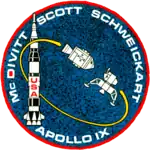 |
March 3, 1969
16:00 GMT Launch Complex 39A |
James McDivitt David Scott Rusty Schweickart |
Saturn V
(SA-504) |
Gumdrop | Spider | 10 d 01 h 00 m 54 s | First crewed flight test of Lunar Module; tested propulsion, rendezvous and docking in Earth orbit. EVA tested the Portable Life Support System (PLSS). | [1][8][27][28][29] |
| Apollo 10 | 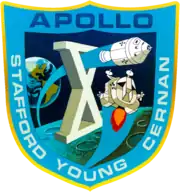 |
May 18, 1969
16:49 GMT Launch Complex 39B |
Thomas P. Stafford John Young Eugene Cernan |
Saturn V
(SA-505) |
Charlie Brown | Snoopy | 08 d 00 h 03 m 23 s | "Dress rehearsal" for lunar landing. The LM descended to 8.4 nautical miles (15.6 km) from lunar surface. | [1][8][30][31][32] |
| Apollo 11 |  |
July 16, 1969
13:32 GMT Launch Complex 39A |
Neil Armstrong Michael Collins Edwin "Buzz" Aldrin |
Saturn V
(SA-506) |
Columbia | Eagle | 08 d 03 h 18 m 35 s | First crewed landing in Sea of Tranquility (Tranquility Base) including a single surface EVA. | [1][8][3][33] |
| Apollo 12 | 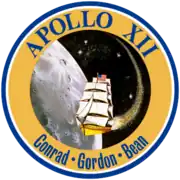 |
November 14, 1969
16:22 GMT Launch Complex 39A |
Charles (Pete) Conrad Richard F. Gordon Jr. Alan Bean |
Saturn V
(SA-507) |
Yankee Clipper | Intrepid | 10 d 04 h 36 m 24 s | First precise Moon landing in Ocean of Storms near Surveyor 3 probe. Two surface EVAs and returned parts of Surveyor to Earth. | [1][8][34][35] |
| Apollo 13 | 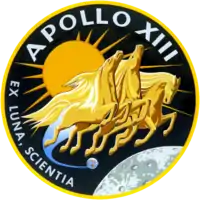 |
April 11, 1970
19:13 GMT Launch Complex 39A |
James Lovell Jack Swigert Fred Haise |
Saturn V
(SA-508) |
Odyssey | Aquarius | 05 d 22 h 54 m 41 s | Intended Fra Mauro landing cancelled after SM oxygen tank exploded. LM used as "lifeboat" for safe crew return. First S-IVB stage impact on Moon for active seismic test. | [1][8][36][7] |
| Apollo 14 | January 31, 1971
21:03 GMT Launch Complex 39A |
Alan Shepard Stuart Roosa Edgar Mitchell |
Saturn V
(SA-509) |
Kitty Hawk | Antares | 09 d 00 h 01 m 58 s | Successful Fra Mauro landing. Broadcast first color TV images from lunar surface (other than a few moments at the start of the Apollo 12 moonwalk.) Conducted first materials science experiments in space. Conducted two surface EVAs. | [1][8][37][38] | |
| Apollo 15 | 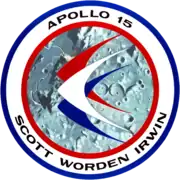 |
July 26, 1971
13:34 GMT Launch Complex 39A |
David Scott Alfred Worden James Irwin |
Saturn V
(SA-510) |
Endeavour | Falcon | 12 d 07 h 11 m 53 s | Landing at Hadley–Apennine. First extended LM, three-day lunar stay. First use of Lunar Roving Vehicle. Conducted three lunar surface EVAs and one deep space EVA on return to retrieve orbital camera film from SM. | [1][8][39][40] |
| Apollo 16 |  |
April 16, 1972
17:54 GMT Launch Complex 39A |
John Young Ken Mattingly Charles Duke |
Saturn V
(SA-511) |
Casper | Orion | 11 d 01 h 51 m 05 s | Landing in Descartes Highlands. Conducted three lunar EVAs and one deep space EVA. | [1][8][41][42] |
| Apollo 17 |  |
December 7, 1972
05:33 GMT Launch Complex 39A |
Eugene Cernan Ronald Evans Harrison Schmitt |
Saturn V
(SA-512) |
America | Challenger | 12d 13 h 51 m 59 s | Landing at Taurus–Littrow. First professional geologist on the Moon. First night launch. Conducted three lunar EVAs and one deep space EVA. | [1][8][9][43] |
Canceled missions
Several planned missions of the Apollo program were canceled for a variety of reasons, including changes in technical direction, the Apollo 1 fire, hardware delays, and budget limitations.
- Before the Apollo 1 fire, two crewed Block I spacecraft missions were planned, but then it was decided that the second one would give no more information about the spacecraft performance not obtained from the first, and could not carry out extra activities such as EVA, and was canceled.
- The Saturn V's all-up testing strategy and relatively good success rate accomplished the first Moon landing on the sixth flight, leaving ten available for Moon landings through Apollo 20,[44] but waning public interest in the program led to decreased Congressional funding, forcing NASA to economize. First, Apollo 20 was cut to make a Saturn V available to launch the Skylab space station whole instead of building it on-orbit using multiple Saturn IB launches.[45] Eight months later, Apollo 18 and 19 were also cut to further economize, and because of fears of increased chance of failure with a large number of lunar flights.[46][47]
| As planned | As flown | ||||||||||||
|---|---|---|---|---|---|---|---|---|---|---|---|---|---|
| Mission | Type | Date | Landing site | CDR | CMP | LMP | Mission | Launch date | Landing site | CDR | CMP | LMP | |
| Apollo 12 | H | November 1969 | Ocean of Storms | Pete Conrad | Richard F. Gordon Jr. | Alan Bean | Apollo 12 | November 14, 1969 | Ocean of Storms | Pete Conrad | Richard F. Gordon Jr. | Alan Bean | |
| Apollo 13 | H | March 1970 | Fra Mauro highlands | Alan Shepard | Stuart Roosa | Edgar Mitchell | Apollo 13 | April 11, 1970 | Failed | Jim Lovell | Jack Swigert | Fred Haise | |
| Apollo 14 | H | July 1970 | Censorinus crater | Jim Lovell | Ken Mattingly | Fred Haise | Apollo 14 | January 31, 1971 | Fra Mauro highlands | Alan Shepard | Stuart Roosa | Edgar Mitchell | |
| Apollo 15 | H | November 1970 | Littrow crater | David Scott | Alfred Worden | James Irwin | Apollo 15 | 26 July 1971 | Littrow crater | David Scott | Alfred Worden | James Irwin | |
| Apollo 16 | J | April 1971 | Tycho crater | John Young | Jack Swigert | Charles Duke | Apollo 15 | July 26, 1971 | Hadley Rille | David Scott | Al Worden | James Irwin | |
| Apollo 17 | J | September 1971 | Marius Hills | Gene Cernan | Ronald Evans | Joe Engle | Apollo 16 | April 16, 1972 | Descartes Highlands | John Young | Ken Mattingly | Charles Duke | |
| Apollo 18 | J | February 1972 | Schroter's Valley | Richard F. Gordon Jr. | Vance Brand | Harrison Schmitt | Apollo 17 | December 7, 1972 | Taurus-Littrow | Gene Cernan | Ronald Evans | Harrison Schmitt | |
| Apollo 19 | J | July 1972 | Hyginus Rille | Fred Haise | William Pogue | Gerald Carr | CANCELED September, 1970 | ||||||
| Apollo 20 | J | December 1972 | Copernicus crater | Stuart Roosa | Don L. Lind | Jack Lousma | CANCELED January 4, 1970 | ||||||
See also
There were two NASA post-Apollo crewed spaceflight programs that used Apollo hardware:[48]
- Skylab § Mission designations – space laboratory missions lasting up to 83 days
- Apollo–Soyuz – first joint US / Soviet crewed spaceflight
Notes
- ↑ Although the A-type designation was used in official documents to refer only to Apollo 4 and Apollo 6,[1]: 466 specifically their uncrewed orbital flights of the CSM and use of the Saturn V rocket, Samuel C. Phillips also used the A-type designation to refer to AS-201, AS-203 and AS-202: "A. Unmanned flights of launch vehicles and the CSM, to demonstrate the adequacy of their design and to certify safety for men. Five of these flights were flown between February 1966 and April 1968; Apollo 6 was the last."[14]
- ↑ Serial number displayed in parentheses
References
- 1 2 3 4 5 6 7 8 9 10 11 12 13 14 15 16 17 18 19 20 21 22 23 24 25 26 27 28 29 30 31 32 33 34 35 36 37 38 39 40 41 42 43 Apollo Program Summary Report (PDF) (Report). NASA. April 1975. JSC-09423. Retrieved September 29, 2017.
- ↑ Bongat, Orlando (September 16, 2011). "Little Joe II". NASA. Retrieved January 30, 2019.
- 1 2 "Apollo 11 (AS-506)". Smithsonian National Air and Space Museum. Archived from the original on February 9, 2021. Retrieved March 10, 2020.
- ↑ Riley, Christopher (December 15, 2012). "Apollo 40 years on: how the moon missions changed the world for ever". The Guardian. Retrieved January 1, 2019.
- ↑ "Lunar Rocks and Soils from Apollo Missions". NASA. September 1, 2016. Retrieved January 30, 2019.
- 1 2 3 4 5 Teitel, Amy (October 28, 2013). "What Happened to Apollos 2 and 3?". Popular Science. Retrieved March 3, 2018.
- 1 2 Apollo 13 Mission Report (PDF) (Report). NASA. September 1970. MSC-02680. Retrieved September 29, 2017.
- 1 2 3 4 5 6 7 8 9 10 11 12 13 14 15 16 17 18 19 20 21 22 23 Hallion & Crouch, pp. 153–159
- 1 2 3 4 5 6 7 8 9 10 11 12 13 14 15 16 17 18 19 20 21 22 23 24 Apollo 17 Mission Report (PDF) (Report). NASA. March 1973. JSC-07904. Retrieved September 21, 2017.
- ↑ von Braun, Wernher (1975). "3.4". In Cortright, Edgar M. (ed.). Apollo Expeditions to the Moon. NASA Langley Research Center. p. 50. ISBN 978-9997398277. Archived from the original on February 14, 2008. Retrieved February 27, 2008.
- 1 2 Brooks, Courtney G.; Grimwood, James M.; Swenson, Loyd S. (1979). "Tragedy and Recovery". Chariots for Apollo: A History of Manned Lunar Spacecraft. NASA.
- ↑ Murray, Charles; Cox, Catherine Bly (1989). Apollo: The Race to the Moon. Simon and Schuster. pp. 315–16. ISBN 9780671706258.
- ↑ Cortright, Edgar M., ed. (2019). Apollo Expeditions to the Moon. Dover. p. 171. ISBN 9780486836522.
- 1 2 3 4 5 6 7 8 9 Cortright, Edgar M., ed. (2019). Apollo Expeditions to the Moon. Dover. p. 172. ISBN 9780486836522.
- 1 2 "Part 2(D) – July through September 1967". The Apollo Spacecraft – A Chronology. Volume IV. NASA. 1975. Retrieved January 29, 2008.
- ↑ Shayler, David (August 26, 2002). Apollo: The Lost and Forgotten Missions. Springer Science & Business Media. pp. 117, 124–125. ISBN 9781852335755.
- ↑ Evans, Ben (December 17, 2017). "Walking in the Void: 45 Years Since the Last Deep-Space EVA". AmericaSpace. Retrieved January 30, 2019.
- ↑ "Apollo 1". NASA. June 14, 2012. Retrieved February 15, 2017.
- ↑ "Apollo 1 (AS-204)". Smithsonian National Air and Space Museum. Archived from the original on July 4, 2017. Retrieved September 21, 2017.
- ↑ Garber, Steve (September 10, 2015). "Apollo-1 (AS-204)". NASA. Retrieved September 29, 2017.
- ↑ "Apollo 7". NASA. July 8, 2009. Retrieved February 15, 2017.
- ↑ "Apollo 7 (AS-205)". Smithsonian National Air and Space Museum. Archived from the original on July 4, 2017. Retrieved September 21, 2017.
- ↑ Apollo 8 Mission Report (PDF) (Report). NASA. February 1969. MSC-PA-R-69-1. Retrieved September 29, 2017.
- ↑ "Apollo 8". NASA. July 8, 2009. Retrieved September 12, 2017.
- ↑ "Apollo 8 (AS-503)". Smithsonian National Air and Space Museum. Archived from the original on July 4, 2017. Retrieved September 21, 2017.
- ↑ Apollo 8 Mission Report (PDF) (Report). NASA. February 1969. MSC-PA-R-69-1. Retrieved September 29, 2017.
- ↑ "Apollo 9". NASA. July 8, 2009. Retrieved September 12, 2017.
- ↑ "Apollo 9 (AS-504)". Smithsonian National Air and Space Museum. Archived from the original on July 4, 2017. Retrieved September 21, 2017.
- ↑ Apollo 9 Mission Report (PDF) (Report). NASA. May 1969. MSC-PA-R-69-2. Retrieved September 29, 2017.
- ↑ "Apollo 10". NASA. July 8, 2009. Retrieved September 12, 2017.
- ↑ "Apollo 10 (AS-505)". Smithsonian National Air and Space Museum. Archived from the original on July 4, 2017. Retrieved September 21, 2017.
- ↑ Apollo 10 Mission Report (PDF) (Report). NASA. August 1969. MSC-00126. Retrieved September 29, 2017.
- ↑ Apollo 11 Mission Report (PDF) (Report). NASA. November 1969. MSC-00171. Retrieved September 29, 2017.
- ↑ "Apollo 12 (AS-507)". Smithsonian National Air and Space Museum. Retrieved November 11, 2022.
- ↑ Apollo 12 Mission Report (PDF) (Report). NASA. March 1970. MSC-01855. Retrieved September 29, 2017.
- ↑ "Apollo 13 (AS-508)". Smithsonian National Air and Space Museum. Retrieved November 11, 2022.
- ↑ "Apollo 14 (AS-509)". Smithsonian National Air and Space Museum. Retrieved November 11, 2022.
- ↑ Apollo 14 Mission Report (PDF) (Report). NASA. May 1971. MSC-04112. Retrieved September 29, 2017.
- ↑ "Apollo 15 (AS-510)". Smithsonian National Air and Space Museum. Retrieved November 11, 2022.
- ↑ Apollo 15 Mission Report (PDF) (Report). NASA. December 1971. MSC-05161. Retrieved September 29, 2017.
- ↑ "Apollo 16 (AS-511)". Smithsonian National Air and Space Museum. Retrieved November 11, 2022.
- ↑ Apollo 16 Mission Report (PDF) (Report). NASA. December 1971. MSC-07230. Retrieved September 29, 2017.
- ↑ "Apollo 17 (AS-512)". Smithsonian National Air and Space Museum. Retrieved November 11, 2022.
- ↑ Williams, David (December 11, 2003). "Apollo 18 through 20 - The Cancelled Missions". National Aeronautics and Space Administration. Retrieved March 3, 2018.
- ↑ "Apollo 20". Astronautix. Archived from the original on October 13, 2016. Retrieved March 15, 2018.
- ↑ Silber, Kennith (July 16, 2009). "Down to Earth: The Apollo Moon Missions That Never Were". Scientific American. Retrieved January 1, 2019.
- ↑ Rousseau, Steve (September 2, 2011). "Why Apollo Really Stopped at 17". Popular Mechanics. Retrieved March 3, 2018.
- ↑ "The Skylab Program". NASA History Office. October 22, 2004. Retrieved March 15, 2018.
 This article incorporates public domain material from websites or documents of the National Aeronautics and Space Administration.
This article incorporates public domain material from websites or documents of the National Aeronautics and Space Administration.
Bibliography
- Hallion, Richard P.; Crouch, Tom D. (1979). Apollo: Ten Years Since Tranquility Base. Smithsonian Institution. Bibcode:1979atys.book.....H. ISBN 978-0874745054.
